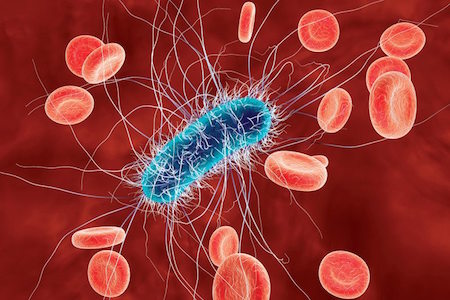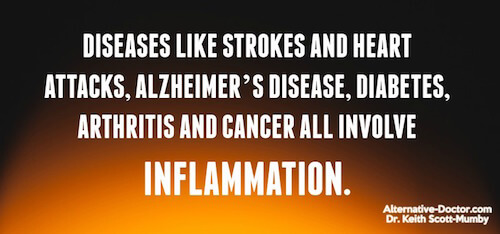Ask any “properly trained” medical scientist about bacteria in healthy blood and they will answer that there are none. Blood is essentially sterile.
This out-moded science is getting a lot of people killed.
Anyone who has ever looked at a LIVE blood sample (freshly taken) under a dark-field microscope will tell you that blood is CRAWLING with micro-organisms. In fact, as my friend Dr. Garry Gordon joked, they are trying to re-cycle us before we are even dead!
This is the basis of ridiculous ongoing controversy, like the Raymond Royal Rife story: Rife saw unknown microorganisms he named bacillus-BX. He reckoned this organism was capable of causing cancer. Scientists insist its quackery; there is nothing there!
Same with Gaston Naessens, a French microbiologist, who saw little organelles he named “somatids” (see Cancer Research Secrets). These too Naessens thought were the cause of cancer (there is not enough info to decide if these are identical with Rife’s bacillus-BX).
 E. coli bacterium in blood
E. coli bacterium in blood
The stupidity of this story is that scientists today DON’T LOOK AT LIVING BLOOD! They use electron microscopy, which has formidable magnification, but the specimen has to be 100% totally DEAD and therefore you are doing wondrous magnification on a specimen which is, essentially, rubbish!
It’s mind-boggling that scientists and supposed experts cannot see the irony in this. But it’s part of the “life is stuff” mentally, bequeathed us by the materialistic, reductionist scientists, who continue to believe that life is a property of a select few atoms and molecules.
Well… THINGS ARE CHANGING! Yay!
Researchers have been looking at blood and finding surprise micro-organisms which could be responsible for a whole host of diseases, by causing systemic inflammation (systemic means “body-wide”). Diseases like strokes and heart attacks, alzheimer’s disease, diabetes, arthritis and cancer all involve inflammation.
It has now emerged that even schizophrenia has an inflammatory element and this may well turn out to be the primary underlying mechanism of this disorder. We DO know that schizophrenic brains have an abnormally high content of immune cells, capable of causing inflammation (microglial cells).
Depression and bipolar disorder too are inflammatory in nature. Settle down the inflammation in the body and the person cheers up! No need for Prozac and such garbage. A low inflammatory diet plus omega-3s will work wonders that drug therapy never can.
There is a link to cancer, too. Inflammation is seen in cancer and the anti-inflammatory drug aspirin is known to lower cancer rates. Aspirin is reported to bind free iron, which together may suggest bacteria have a hidden role in this disease too.

But, here’s the new stuff: these conditions are also all linked to overactive blood clotting, excessive levels of iron in the blood, and sheets of abnormally folded proteins.
No one knows why these traits are linked to so many diseases, but finding out could help us stop them. To see if bacteria could be playing a role in all this, Douglas Kell at my old Alma Mater (University of Manchester, UK) and Resia Pretorius, at the University of Pretoria in South Africa, have been looking at the ability of these micro-organisms to disrupt clotting.
As I said, blood has always been considered free from microbes, because bacteria don’t grow when it is put in a culture dish. But recent DNA sequencing methods reveal that each millilitre of blood in fact contains around 1000 bacterial cells.
These bacteria are mostly dormant; but add a dash of iron and the story changes dramatically. In the presence of iron, these bacteria awake and begin secreting substances called lipopolysaccharides, molecules on their cell walls that attract the immune system and create an inflammatory response.
This is really BIG news!
Kell and Pretorius checked into this by taking gut bacteria, E. coli, and mixing them with fibrinogen. The result was big clotting (fibrinogen is the precursor molecule that changes into fibrin when the blood clots). You only need to know that the main bacteria found in blood are E. coli types and suddenly we have a whole plausible model sprung into view.
“In all inflammatory conditions we have noted a matted, denser fibrin structure, without the typical ‘spaghetti structure’ found in healthy individuals,” says Pretorius. This aberrant clotting material is definitive.
What I found fascinating was that just one molecule of lipopolysaccharide in a mixture of a hundred million fibrinogen molecules will result in clotting.
That means the lipopolysaccharides are acting as the equivalent of an enzyme catalyst. The researchers think lipopolysaccharides bend fibrinogen out of shape, and this shape-change spreads from protein to protein (in a similar way to the deformation associated with prion proteins that cause BSE).
The really bad news is that inflammation and raised fibrinogen levels in the blood together spell trouble. It far increases the risk of a disaster such as a clot in the heart (a “coronary”) or clot in the brain (a stroke).
And it bears repeating that these are aberrant disease-linked clots, which, because of their weird structure, are also resistant to being broken down by blood enzymes.
Fighting Inflammation
Overactive clotting is also a feature of inflammatory conditions like rheumatoid arthritis, Parkinson’s disease and Alzheimer’s, as I said. Now, these conditions involve excess levels of iron. The body normally keeps levels of free iron in the blood low to keep bacteria dormant and block their growth. It does this by binding it to ferritin (see below).
As I wrote for you in a recent newsletter (Can You Catch Alzheimer’s? 1 Jun 2016) that the amyloid plaques, so distinctive of Alzheimer’s disease, are more likely to be in inflammatory defense response to bacterial infection than the actual cause of AD. In fact earlier this year, other researchers found that injecting bacteria into the brains of mice prompted them to form amyloid plaques overnight.
What does this all mean for these diseases? Further research could open up several new approaches for tackling them, from removing dormant microbes from our blood, to blocking the inflammatory proteins that they shed.
Cranky old Jim Humble, with his MMS (chlorine dioxide protocol) may be onto something after all!
So Should We Take Iron Supplements?
In one sentence, if you are not of reproductive years, it’s safer not to.
Most iron in our bodies is incorporated in hemoglobin, which carries oxygen in the blood, and in myoglobin in muscle, but every living cell has and needs iron to function.
Iron is also stored in the liver, spleen and bone marrow. Without it, your cells would become starved for oxygen, your brain and muscles wouldn’t function, and your immune system would be impaired, among other problems.
But that doesn’t mean most people need to take an iron supplement—or even a multivitamin/mineral pill that contains iron. In fact, too much iron can be dangerous, as we have seen.
As a 2007 review from the University of Michigan Medical School hypothesized, iron fuels the generation of cell-damaging free radicals, which “takes its toll in the later years of life.”
Check Your Ferritin Levels
We now have a clearer understanding of the perils of iron. You may need to get your serum ferritin levels checked. Ferritin is a protein in the body that binds to iron; most of the iron stored in the body is bound to ferritin. The amount of ferritin in the blood gives an indication how much iron is stored in your body.
If it’s high, you are in great danger of being really hurt by bacterial infections. For men, it should not go above 275 ng. per ml. For women, probably not above 175 ng. per ml.
I’ve explained all this in my super book “How To Survive In A World Without Antibiotics”.
I also explained the story of “hot iron” in my blockbuster “How to Live Beyond 100 Years.” Again, I explain why iron is probably one of the deadliest aging free-radicals of all; it makes ozone, free oxygen and peroxide seem quite tame!
It’s very strange, isn’t it? After a century of propaganda about iron pills and anemia, we now know that free iron is almost too hot to handle. Hey, wasn’t that the title of a 30s Clark Gable movie?
Here’s to knowledge. It saves lives!
Sources:
Bacteria lurking in blood could be culprit in countless diseases, New Scientist, Magazine issue 3091, published 17 September 2016.
(Journal of the Royal Society Interface, doi.org/bqh5).
Journal of the Royal Society Interface, DOI: 10.1098/rsif.2016.0539
The Good and Bad of Iron. 2013. Berkeley Wellness.
The post A Whole NEW Take On Diseases & Fighting Inflammation appeared first on Dr. Keith Scott-Mumby.
